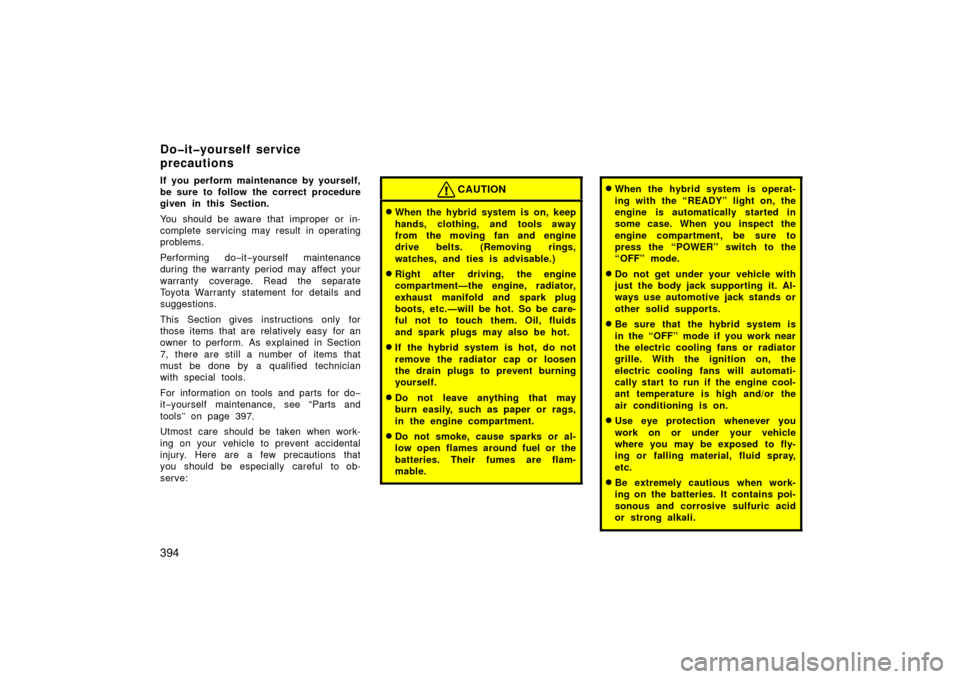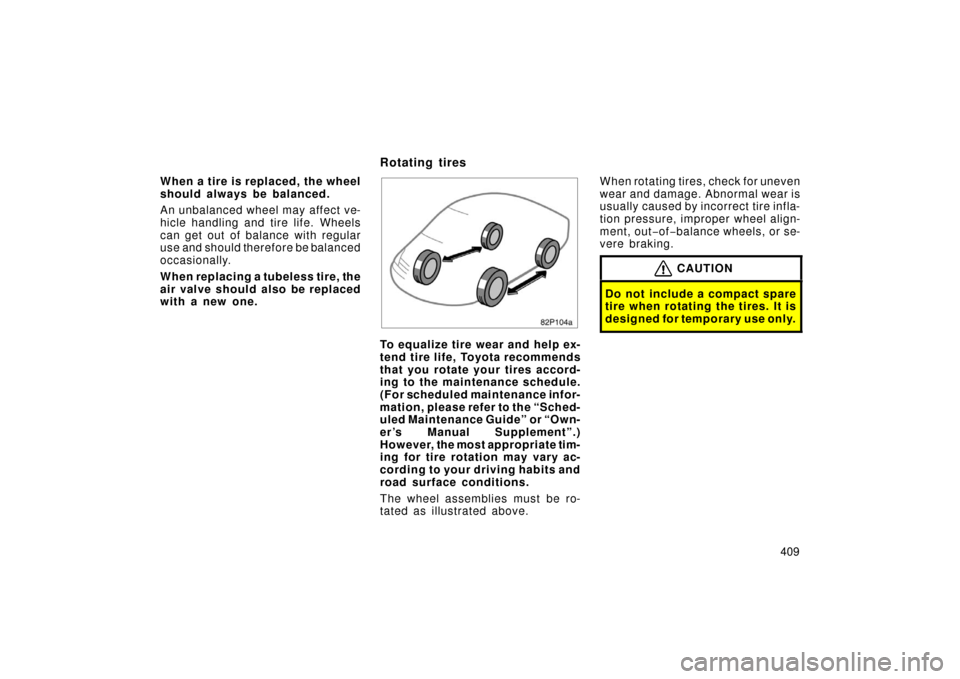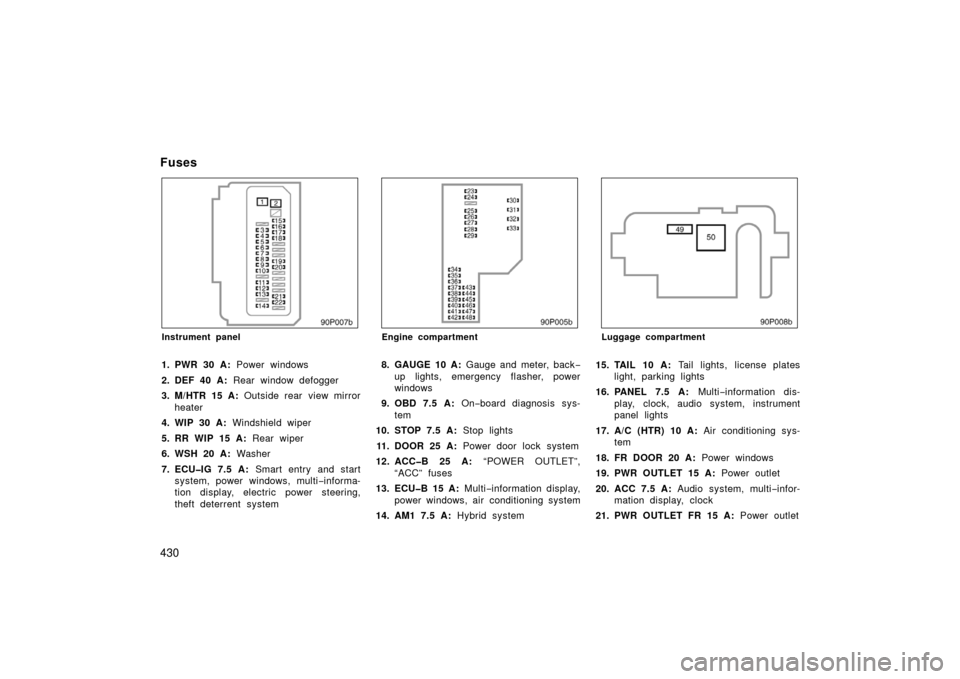Page 394 of 455

394
If you perform maintenance by yourself,
be sure to follow the correct procedure
given in this Section.
You should be aware that improper or in-
complete servicing may result in operating
problems.
Performing do−it−yourself maintenance
during the warranty period may affect your
warranty coverage. Read the separate
Toyota Warranty statement for details and
suggestions.
This Section gives instructions only for
those items that are relatively easy for an
owner to perform. As explained in Section
7, there are still a number of items that
must be done by a qualified technician
with special tools.
For information on tools and parts for do −
it −yourself maintenance, see “Parts and
tools” on page 397.
Utmost care should be taken when work-
ing on your vehicle to prevent accidental
injury. Here are a few precautions that
you should be especially careful to ob-
serve:CAUTION
�When the hybrid system is on, keep
hands, clothing, and tools away
from the moving fan and engine
drive belts. (Removing rings,
watches, and ties is advisable.)
�Right after driving, the engine
compartment—the engine, radiator,
exhaust manifold and spark plug
boots, etc.—will be hot. So be care-
ful not to touch them. Oil, fluids
and spark plugs may also be hot.
�If the hybrid system is hot, do not
remove the radiator cap or loosen
the drain plugs to prevent burning
yourself.
�Do not leave anything that may
burn easily, such as paper or rags,
in the engine compartment.
�Do not smoke, cause sparks or al-
low open flames around fuel or the
batteries. Their fumes are flam-
mable.
�When the hybrid system is operat-
ing with the “READY” light on, the
engine is automatically started in
some case. When you inspect the
engine compartment, be sure to
press the “POWER” switch to the
“OFF” mode.
�Do not get under your vehicle with
just the body jack supporting it. Al-
ways use automotive jack stands or
other solid supports.
�Be sure that the hybrid system is
in the “OFF” mode if you work near
the electric cooling fans or radiator
grille. With the ignition on, the
electric cooling fans will automati-
cally start to run if the engine cool-
ant temperature is high and/or the
air conditioning is on.
�Use eye protection whenever you
work on or under your vehicle
where you may be exposed to fly-
ing or falling material, fluid spray,
etc.
�Be extremely cautious when work-
ing on the batteries. It contains poi-
sonous and corrosive sulfuric acid
or strong alkali.
Do�it�yourself service
precautions
Page 409 of 455

409
When a tire is replaced, the wheel
should always be balanced.
An unbalanced wheel may affect ve-
hicle handling and tire life. Wheels
can get out of balance with regular
use and should therefore be balanced
occasionally.
When replacing a tubeless tire, the
air valve should also be repl
aced
w i t h a new on e.
82p104a
To equalize tire wear and help ex-
tend tire life, Toyota recommends
that you rotate your tires accord-
ing to the maintenance schedule.
(For scheduled maintenance infor-
mation, please refer to the “Sched-
uled Maintenance Guide” or “Own-
er’s Manual Supplement”.)
However, the most appropriate tim-
ing for tire rotation may vary ac-
cording to your driving habits and
road surface conditions.
The wheel assemblies must be ro-
tated as illustrated above. When rotating tires, check for uneven
wear and damage. Abnormal wear is
usually caused by incorrect tire infla-
tion pressure, improper wheel align-
ment, out
−of −balance wheels, or se-
vere braking.
CAUTION
Do not include a compact spare
tire when rotating the tires. It is
designed for temporary use only.
Rotating tires
Page 430 of 455

430
90p007b
Instrument panel
1. PWR 30 A: Power windows
2. DEF 40 A: Rear window defogger
3. M/HTR 15 A: Outside rear view mirror
heater
4. WIP 30 A: Windshield wiper
5. RR WIP 15 A: Rear wiper
6. WSH 20 A: Washer
7. ECU�IG 7.5 A: Smart entry and start
system, power wi ndows, multi−informa-
tion display, electric power steering,
theft deterrent system
90p005b
Engine compartment
8. GAUGE 10 A: Gauge and meter, back −
up lights, emergency flasher, power
windows
9. OBD 7.5 A: On−board diagnosis sys-
tem
10. STOP 7.5 A: Stop lights
11. DOOR 25 A: Power door lock system
12. ACC�B 25 A: “POWER OUTLET”,
“ACC” fuses
13. ECU�B 15 A: Multi−information display,
power windows, air conditioning system
14. AM1 7.5 A: Hybrid system
90p008b
Luggage compartment
15. TAIL 10 A: Tail lights, license plates
light, parking lights
16. PANEL 7.5 A: Multi−information dis-
play, clock, audio system, instrument
panel lights
17. A/C (HTR) 10 A: Air conditioning sys-
tem
18. FR DOOR 20 A: Power windows
19. PWR OUTLET 15 A: Power outlet
20. ACC 7.5 A: Audio system, multi −infor-
mation display, clock
21. PWR OUTLET FR 15 A: Power outlet
Fuses
Page 441 of 455

441
�SRS airbag deployment data
� SRS airbag system diagnostic
data
If your vehicle is equipped with a
vehicle stability control (VSC) sys-
tem, its Electronic Control Unit
(ECU) may contain another EDR.
There are a variety of driving situ-
ations which include activating the
VSC under which the VSC EDR
will record certain information. The
VSC EDR may record some or all
of the following information:
� Behavior of the vehicle
� Steering wheel angle
� Vehicle speed
� To what extent the accelerator
pedal was depressed
� To what extent the brake ped-
al was applied
� To what extent the ECU con-
trolled the condition of the 4
wheels
� Vehicle stability control sys-
tem diagnostic data
The information above is intended
to be used for the purpose of im-
proving vehicle safety perfor-
mance. Unlike general data record-
ers, the EDR does not record
sound data such as conversation
between passengers.Toyota will not disclose the data
recorded in an EDR to a third
party except when:
� An agreement from the ve-
hicle’s owner (or the leasing
company for a leased vehicle)
is obtained
� Officially requested by the po-
lice or other authorities
� Used as a defence for Toyota
in a law suit
� Ordered by the court
However, if necessary Toyota will:
� Use the data for research on
Toyota vehicle safety perfor-
mance
� Disclose the data to a third
party for research purposes
without disclosing details of
the vehicle owner, and only
when it is deemed necessary
� Disclose summarized data
cleared of vehicle identifica-
tion information to a non −To -
yota organization for research
purposes